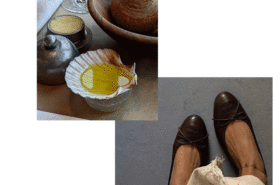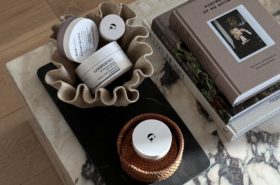
I will preface the rest of this post with a full confession that I definitely used to be one of those people that loved all of the supplements and powders out there on the market. You know, the ones claiming that they would give you eternal youth, provide the ultimate detox, and make you healthiest person on earth. Needless to say I swung a little far in one direction. However, over the years I’ve come to realize that if I am eating whole food diet that is rich in darkly leafy greens, colorful fruits and vegetables and high quality animal products, then I don’t need all of the fancy powders.
That being said, I’ve found a few supplements, protein powders, and adaptogens that work for me and therefore I like to keep on hand and use in smoothies in lattes. While I know I’m not a doctor, so by no means is this any type of this medical advice, I do recommend that if you do take or use supplements that you make sure that they are right for you. Do your research, make sure you’re getting good quality products and listen to your body.
Collagen
I originally started using collagen for gut and digestive health. I’ve seen minor improvement, however the biggest difference that I’ve noticed is in my skin, hair and nails. I typically use Vital Proteins collagen, but I’ll be totally honest in that I haven’t tried other brands. I do know that Moon Juice has a Vegan Shroom Collagen which consists of ingredients that are not derived from animals and help preserve the skin’s collagen, but I haven’t personally tried it. Do I need to take collagen? No probably not, I eat a ton of antioxidants in my diet which help prevent aging, but at this point I’ve gotten addicted to how frothy and creamy it makes my lattes!
Adaptogens
This has been a more recent addition for me over the past year and to be honest, it’s been the most helpful for me. Adaptogens are a category of herbs that help the body adapt to stress and can have a normalizing effect on the body. According to Adaptogens: Herbs for Strength, Stamina and Stress Relief, adaptogens “increase the body’s resistance to physical, biological, emotional, and environmental stressors and promote normal physiological function.”
Last year I decided to get my Nutrition Genome done. To drastically oversimplify what it is, it’s kind of like 23 and Me on steroids. Based on my genes and my genetic SNPs, I have a higher sensitivity to stress and don’t break down dopamine, adrenaline and estrogen as well as some other people. Translation – when I kick into high gear, it takes my body longer to come back down to neutral. As a result, the effects of stress on my body continue even if I am no longer “stressed“.
Another thing to note, when I started dabbling in adaptogens I was struggling with amenhorrea (when one loses their period, but has not gone through menopause). A lot of my initial adaptogen choices were to boost my body’s ability to produce and/or regulate sex and stress hormones. If you are interested in adaptogens, there’s a lot of good resources out there, Mind Body Green, goop, and The Chalkboard Mag, all have great resources that are short and sweet, and Adaptogens: Herbs for Strength, Stamina, and Stress Relief is a great book if you’re looking for something more in-depth.
- Ashwaghanda – Probably one of the more popular adaptogens that you see in wellness cafes. It is a calming adaptogen that has been found to enhance endocrine function and regulate the adrenal glands, and as a result, the body’s response to stress. I started taking it to help my body combat the effects of stress and anxiety.
- Lions Mane – A medicinal mushroom known for it’s mental and cognitive benefits. I use it for mental clarity and enhanced focus.
- Pine Pollen – I started taking this when I was struggling with hormonal imbalance and amenhorrea. I primarily used it for its hormone boosting and balancing effects. It is a natural source of DHEA which is a precursor to testosterone, progesterone and estrogen. Even though I no longer have issues with my cycle, I still take it for health and longevity.
- Cordyceps – I was drawn to this mushroom purely by intuition, however the more I’ve read about it, the more it makes sense for me. It was actually suggested in my Nutrition Genome as a way to increase genetic function of a gene that I had a SNP in.
- Reishi – Another medicinal mushroom that has been around for centuries in many cultures. It is one of the most studied medicinal mushrooms so there’s a decent amount of literature out there if you want to learn more. I started using this for stress relief and immune support.
- He Shou Wu – Another adaptogen that I originally started using when I was struggling with hormonal imbalances, however have since continued to use it for its longevity, anti-aging and rejuvenation {especially hair and skin} properties. He Shou Wu promotes Yin {I like to think of it as the feminine energy} in the body and harmonizes and calms the nervous system making it a great alternative to stress relief. Conscious Lifestyle Magazine has a great in-depth article on the benefits and medicinal properties of He Shou Wu.
- Maca aka “Peruvian Ginseng” – I started using maca a long time ago when I was having issues with my cycle and hormonal imbalance. It helps support the endocrine system which regulates the body hormone production. It’s been found to increase fertility and decrease menopausal symptoms like fluctuating estrogen levels. Since I had virtually no estrogen floating around, I felt that I could benefit from it. It’s also a natural aphrodisiac, boots energy levels and increases stamina. I also just love the taste. It has a nice malty flavor the goes really well with matcha, coffee and chocolate.
- Yin Power – This is Sun Potions own blend of yin promoting adaptogens. A lot of the above are it, including tocotrienols, aka “tocos”, which is a plant based food source of vitamin E {great for the skin}. It’s a nice one stop shop for adaptogens.
I personally use a lot of Sun Potions adaptogens and Peak and Valley, however I’ve also tried Moon Juice and Mountain Rose Herb and liked those as well. Your local co-op or health food store would also be a good resource if you’re looking to dabble in adaptogens.
Spirulina, Blue-Green Algea, and/or Chlorella
I only add these to green smoothies. I love the above “green things” because you get a lot of bang for your buck {they are true superfoods}, and while they vary slightly in their components {think of them as cousins}, they are both found to calm inflammation, protect the cells and detoxify the body.
Spirulina is roughly 60-70% of complete protein (warning: you need 1 tbsp to get just 4 grams of it) and is chock full of vitamins and minerals like A, B, iron, copper, magnesium and potassium. It contains 4x the amount of antioxidants than blueberries, which help protect cellular damage and support the immune system. It also contains gamma linoleum acid (GLA), an essential fatty acid known for its anti-inflammatory properties. Spirulina’s cell wall is easier to digest than chlorella, making it cheaper to make and therefore cheaper to buy.
According to Sun Chlorella’s site, Chlorella contains chlorella growth factory (CGF) – a unique nutrient only found in chlorella’s nucleus, which is found to promote cellular repair, thereby increasing cellular health and energy production (this happens in cells – thank you middle school biology). It also contains active B12, the same B12 found in animal products, making it the only plant source of active B12 (spiraling contains B12, but it is the inactive form) and a great food source of the vitamin for vegans and vegetarians. Chlorella also contains more chlorophyll than spirulina {they both contain a lot of it}, which helps build and oxygenate the blood and detoxify the body. Both chlorella and spiraling are good heavy metal detoxifiers.
Protein Powder
After reading The Clean Label Project’s report on protein powders and heavy metal contamination, I’ve been a bit skeptical about protein powders and use them sparingly. Protein powders also tend to be more heavily processed then whole foods, however they can come in handy when life get’s a little crazy.
When I can, I try to get protein from whole food sources (hemp seeds, nuts, chia seeds, beans, grains, dark leafy greens, and occasionally sustainably raised animal products). However when I can’t, I will add it to my smoothies and lattes to make them more substantial.
My current rotation of protein powders consist of: Vital Protein’s collagen and beef gelatin (I know, it sounds weird, but it makes lattes thick and creamy, it’s delicious in hot chocolate), Moon Juice’s protein powders (I use the vanilla flavor, however they also have chocolate flavor that goes great with coffee and espresso, and a “blue beauty” flavor that contains blue spirulina extract), and Nutiva’s Hemp Protein.
In general, I tend to use vegan protein powders. If I use a whey protein powder I alway always choose 100% grass-fed whey. I also recommend Bulletproof products as they have been known to have a high quality of standard when it comes to sourcing and production. Their coffee is even tested for mold and mycotoxins.
Moringa
A new one that I’ve been playing around with since reading about it’s nutritional properties. It has a pretty strong flavor and will ruin any smoothie if you don’t have enough fruit in it. I don’t recommend it in lattes! It’s also great in soups or sprinkled on salads.
According to Kuli Kuli (brand of choice) moringa is like kale on steroids in terms of nutritional value. It has 2x the protein, 4x the calcium and 6x the iron than kale, not to mention it contains all nine amino acids so it is a complete protein. One serving of moringa is the equivalent of two servings of leafy greens. It supports cardiovascular and gut health and is anti-inflammatory. It’s even been found to improve iron-deficiency anemia.
To Sum It All Up
Do I have these every day? No. I’m a firm believer in trying to get my vitamins and nutrients from whole, un-processed foods. But, the reality is that we live in a fast paced world with high emotional and physical demands and expectation and sometimes the body needs a little extra support. Everyday is different and the key for me is tuning into my body, and emotions, to determine what I need.
I do, however, start every day with a matcha latte (or coffee if I’m really dragging) – it’s one of those things that’s so far engrained in my morning routine that I don’t feel human without it. I couldn’t write all of the above without including a recipe for what is currently in my cup.
Maca Matcha Latte
Ingredients
- 1 cup homemade nut milk* (I love almond-cashew)
- 1 tsp high quality matcha**
- 1 tsp Yin Power
- 1/2 tsp reishi
- 1/4-1/2 tsp maca
- 1 scoop Vital Proteins collagen optional
Directions
- Combine all ingredients in a high-speed blender.
- Blend that sucker on high until it’s hot!
*Heating almond milk on the stove or with a milk frother, prior to blending which will reduce blending time. I use the steaming wand on our espresso machine. Alternatively you can use 1 cup hot water and 1 tbsp coconut butter, 1-2 tbsp nut butter, or 2-4 tbsp cashews. If you do this, add your choice of sweetener to taste.
**I’m currently using Mizuba Matcha’s culinary blend – great for lattes and cooking!




